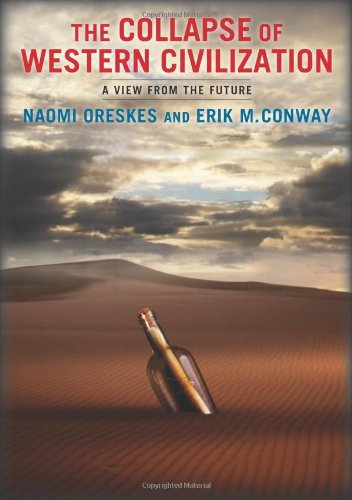

|
| Cover art by Colin Anderson |
| THE COLLAPSE OF WESTERN CIVILIZATION A View from the Future Naomi Oreskes Erik M. Conway New York: Columbia University Press, July 2014 |
Rating: 4.0 High |
|||
| ISBN-13 978-0-231-16954-7 | ||||
| ISBN-10 0-231-16954-X | 89pp. | SC/SF | $9.95 | |
This extended parable is too poorly written to qualify as good fiction. In addition, its authors make a number of elementary mistakes which any experienced fiction writer would easily avoid. They are, of course, academics rather than fiction writers, so this defect in their current work can be forgiven.
More important is the factual scientific basis of the work. A good deal of it is actual history, notably the 2010 blowout of a BP oil well in the Gulf of Mexico, Canada's shift to conservative government, and the expansion of oil-sands and shale-gas extraction. These and other historical events form the "jumping-off point" for the cautionary narrative.
Beyond the year 2014, projection of the future is required. On this does the credibility of the work depend. All good science fiction makes such projections, asking what might happen "If this goes on..." — what the future world might look like if a current trend or multiple trends continue without alteration.
No reliable prediction of the exact nature, degree, and timing of changes is possible. But we can construct scenarios that give us an idea of what can be expected.
What can be expected is:
All these changes will discomfit the world's human population. People will be displaced from low-lying areas. Growing crops will become difficult in many places. Drinking water, edible plants, and food animals will be scarcer and more expensive. Law and order will be threatened; some nations will rely on military action to protect their land and resources.
No one can say how bad things will get, or how soon trouble will strike any given place. But these things will happen if climate keeps changing as it is changing now.
Here are the current trends and conditions the authors deem relevant to climate change:
"A key attribute of the period was that power did not reside in the hands of those who understood the climate system, but rather in political, economic, and social institutions that had a strong interest in maintaining the use of fossil fuels. Historians have labeled this system the carbon-combustion complex: a network of powerful industries comprising fossil fuel producers, industries that served energy companies (such as drilling and oil field service companies and large construction firms), manufacturers whose products relied on inexpensive energy (especially automobiles and aviation, but also aluminum and other forms of smelting and mineral processing), financial institutions that serviced their capital demands, and advertising, public relations, and marketing firms who promoted their products. Maintaining the carbon-combustion complex was clearly in the self-interest of these groups, so they cloaked this fact behind a network of 'think tanks' that issued challenges to scientific knowledge they found threatening. Newspapers often quoted think tank employees as if they were climate researchers, juxtaposing their views against those of epistemologically independent university or government scientists. This practice gave the public the impression that the science was still uncertain, thus undermining the sense that it was time to act." Meanwhile, scientists continued to do science, believing, on the one hand, that it was inappropriate for them to speak on political questions (or to speak in the emotional register required to convey urgency) and, on the other hand, that if they produced abundant and compelling scientific information (and explained it calmly and clearly), the world would take steps to avert disaster. – Pages 36-7 |
The dire events they describe, writing from the viewpoint of fictional future historians, are listed in the sidebar. You'll note that there is nothing new about these; others have written books describing similar scenarios. For example, in Climate Wars, Gwynne Dyer imagines eight scenarios involving drowned cities and military conflicts.1 Paleobiologist Peter D. Ward, in Under a Green Sky — his best book, IMO — gives us a glimpse of what a world with dead oceans might be like.2 Dr. Paul Elliott and Stefan Faris look at spreading diseases in, respectively, Changing Planet, Changing Health3 and Forecast.4 In With Speed and Violence, Fred Pearce considers the possibility that the Gulf Stream (aka thermohaline circulation) might stop.5
The big mystery in all of this is the tipping points. No one has any idea when major loss of permafrost might occur, leading to release of huge quantities of greenhouse gases that magnify the effect of the GHGs human activities have produced. But, in Siberia, Alaska, and northern Canada, permafrost breakdown is already increasing.
No one knows for sure when the West Antarctic Ice Sheet will be gone. But big chunks of it have already been lost, and cracks across bigger chunks threaten their loss before too many more years.
No one has a handle on when the oceans will become acid enough to prevent most phytoplankton from growing, or warm enough to kill off most coral reefs. But coral reefs are dying in a number of places, and some species at the bottom of the ocean food chain are already being affected.
I therefore consider The Collapse of Western Civilization a reasonably credible warning of what the future might hold. It starts from a solid, well-documented basis. A gripping tale it is not; but then, even fiction writers who've had a great deal of practice do not always produce a gripping tale. So I'll give this short book a mark of 4 and rate it worth reading.

 To contact Chris Winter, send email to this address.
To contact Chris Winter, send email to this address.